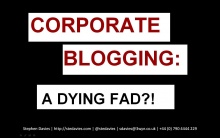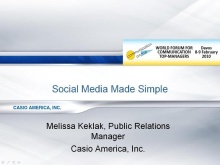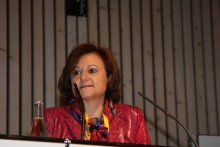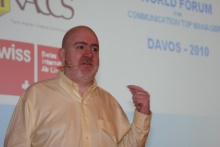Presentations 10

The Corporate Blogging and External Online Communications
Stephen Davies
A few years ago it was proclaimed by some people as the “press release killer.” Extreme enthusiasts predicted it would spell the end of PR. Fast forward to present day and neither is true. Since the advent of new social media (Twitter and Facebook), corporate blogging has taken a step back from the limelight as the most debated online communication channel. S. Davies addresses its current state utilisation (or not) by organisations around the globe. He looks at case studies and best practices and tries to answer the question: Is corporate blogging a dying fad?
View presentation
(to download presentation right-click and "save link as")

Social Revolution. A boom of marketing communications in the social media domain in the CIS countries
Denis Terekhov
Recent changes in the Russian business and its large international enterprises’ approach to communications in social media. D. Terekhov presents an actual data on Russian media landscape and the future of new media on the post-Soviet arena. One of the main topics of his report is opportunities for international integrations in the field of social media communications and how to overcome local content barriers in order to achieve global goals in different markets.
View presentation
(to download presentation right-click and "save link as")

Indicators & dashboards. An approach to measurement: Dassault Aviation
Yves Robins
In the current economic turmoil, efficient communication measurement becomes increasingly necessary, not only for sound assessment and reporting but also for daily management. A suitable blend of IT and measurement tools provides the right answer to such needs. Y. Robins presents a tailor-made set of instruments and discusses:
- Economic environment and the crisis;
- Needs for efficient measurement;
- Dashboard concept: for whom and why;
- Parallel with “glass cockpit”;
- Requirements for indicators selection; Indicators toolbox;
- Media indicators;
- Virtual communication plateau;
- First lessons learned.
View presentation
(to download presentation right-click and "save link as")

Making Social Media Simple: A look back on Casio’s social media
Melissa Keklak
M. Keklak discusses Casio's integration into the Social Media sphere by using tactical social media PR efforts. Her presentation addresses a case study of how the company team has utilized social media to generate buzz from Casio’s brand's 25th anniversary and effectively launch the new company products.
Presentation is available only in summary, as per author's request.

Companies & Environment in the “Comm-Boom” era and “eco2soc” crises
Yannis Freris
Can communication change the world? Y. Freris examines the company-environment relation, taking into account the global ecologic, economic & social crises, the expansion of communication and its means, corporate citizenship, and sustainable civic involvement. He analyzes the paradigm for setting common action platforms (citizens, Eco-scientists, and company employees), the synthesis between environmental care and social solidarity and the use of a landmark as the bridging symbol amplifying worldwide Eco-responsibility.
View presentation
(to download presentation right-click and "save link as")

Communicate the value in your values and turn it into sales. Effectively marketing your social/environmental commitment
Shel Horowitz
Treating the earth with respect, providing a healthy and welcoming atmosphere for employees, donating a portion of your profits, supporting social and environmental goals are all marketing points to help you stand out in your prospects' mind. Harness these points to build sales and customer loyalty to the point that they become part of your unpaid word-of-mouth army of ambassadors. Identify policies conducive to attracting socially and environmentally conscious fans and involve customers with a feeling of "ownership". Turn this reservoir of good will into a powerful, virtually free, marketing machine.
View presentation
(to download presentation right-click and "save link as")

Building Trust in a turmoil Crisis through Change Management comms.
Rui Martins
Success is based on credibility. Receivers should have confidence in the accuracy and truthfulness of the company message. How is this achievable? Change management aligns People – Leadership – Organizational culture. Enhance individuals to manage a positive change by answering sustainability development and organizational needs. Satisfaction, involvement of staff, and change of attitude by Management team involve four levels of communication: Awareness, Understanding, Commitment and Behavioural change – based on a proactive and positive flow of Information, Dialogue, and Recognition. In the new era of horizontal social architecture, the collision between real and virtual and brings new challenges to communication. Key stakeholders can no longer be involved without social and new media (Facebook, Twitter, etc.) – named by EU Communication Monitor’09 “the fast growing channels of interaction”.
View presentation
(to download presentation right-click and "save link as")

Company leaders change role – from management to communication
Andrey Kulinich
In this dynamic world modern leaders are up to greater responsibilities. Business needs new exciting ideas. Communication goes via all possible channels. We change our values. Business and communication lie in a 4-sec distance: grab the opportunity or perish. A. Kulinich examines the corporate changes necessary within a world of fast communication, where basic needs are already fulfilled and the most effective groups are the ones fighting for ideas and principles, rather than for money or profit.
View presentation
(to download presentation right-click and "save link as")

Crisis Communication - Staying Clear of Turbulence
Daniel Holtgen
Air transport is the fastest growing and the safest transport mode. Despite its good safety record, public perception of aviation is rarely rational. A single incident can ruin an airline’s reputation and call aviation regulation into question. Within minutes of the first reports, competing news channels have already made out the causes and culprits of an accident. The challenge for spokespersons of airlines, airports and aviation authorities is to encounter the media blitz with tact, factual information and clear answers to complex questions. Being prepared for a crisis is a matter of “make or break” in the aviation sector. Against the background of a new debate about aviation safety in Europe this session, D. Holtgen looks at lessons learnt from recent air incidents and best practice in the sector.
Presentation is available only in summary, as per author's request.

Communication after crisis. What do companies need? Future PR Keys
Nuria Vilanova
Public Relations consultancy and the directors are facing a great challenge: How to continue being important when this will inevitably be questioned if mass media continues being of leading importance? Media crisis opens PR crisis, if we are not able to evolve. The Three keys of PR today are:
- How to mobilize the staff of the companies to encourage the change from below;
- integrate Public Affairs and corporate communication to support the strategy of the company;
- Integrate on-line communication into street marketing and product communication;
View presentation
(to download presentation right-click and "save link as")

Individual consumers' value orientation
Evgeny Boychenko
Life values are the most stable and important beliefs - their everyday presence saves consumers from going crazy: being in front of "life counters" and forced (due to limited budget) to choose one variant behaviour of the many possible ones, the consumer must stand on a reliable platform inside himself to assess and product in some system of coordinates. Values always appear as a scale with two opposite poles, which helps us to structure the outside world. As a result, our consciousness forms a classifier – a fairly reliable regulator of our behaviour. The hierarchy of values, however, varies: in the different social strata and subcultures the “right-wrong, good-bad” scale is perceived from different viewpoints.
View presentation
(to download presentation right-click and "save link as")

Integrated marketing comms. Growing Relevance in a Seamless Society
Denise Stillman
Since its birth decades ago, integrated marketing communications (IMC) has become more than a popular phrase. It’s a way of life for the modern marketer. Customer-centric marketing using heavy amounts of data has never been more possible than today. Marketers’ reliance on data has drawn them closer to IT experts. A keen understanding of the ability to compete using data will define the success of marketers to come. This session explores the future of IMC taking notes from case studies that examine effective uses of IMC in several industries.
This presentation contains a video: View video online.
View presentation
(to download presentation right-click and "save link as")

Custom made publishing today
Evgeny Grigoriev
USA and EU corporate publications experts state a certain growth in the publishing houses business – this is where the budgets of major marketing and PR companies flow. Production of content and its delivery to the public in various forms is perceived as effective tool of communication with customers. Expansion of transnational corporations leads to ‘clones’ of the original publications for personnel in the countries where their branches function. In times of crisis, internal publications can effectively stabilize social tension by implementing a mission wider than corporate interests. The RU boom of such publications (HR-supervised) reflects the need for adopting modern management to increase production profitability.
View presentation
(to download presentation right-click and "save link as")

Political communications through the credit crunch
Jolyon Kimble
Using case studies from Europe and across the United Kingdom, Jolyon speaks on how governments communicated during the recent credit crunch. He examines how differences in the severity of exposure and variance in the sophistication of communications functions affected the way different countries weathered the storm. Drawing on interviews with those well-placed at the apex of national governments, he rates countries on whether they had 'a good crisis' or a bad one.
View presentation
(to download presentation right-click and "save link as")

From speech writing to blogging – the entropy of political communications
Alexander Anisimov
Modern technologies implicate relevant changes towards more intensive and inter-related political structures. Political communication has abandoned its monologue for a well-voiced interaction. The political backbone experiences “tectonic” changes, so communication is bound to alter. The “umbrella” structure evolved into a “network” functioning mechanism of authorities. This new challenge lead to great innovations (USA presidential elections), yet they were regarded as a tool-kit expansion rather than a challenge to the political message. Today “old-school” speeches are turning into blog-articles. Such a transition requires adequate training and new personal qualities from the politicians.
View presentation
(to download presentation right-click and "save link as")

E-democracy, e-activism and e-revolutions
Rodrigo Moita de Deus
Can e-participation, e-activism and e-engagement change social and political behaviours? Is social media mining our societies’ power and information structure? R. Moita de Deus addresses the “31 da Armada” case study and the potential of consumer generated media in setting media and political agendas. 31 da Armada is, probably, the most popular Portuguese blog. Three years ago they started making journalistic multimedia coverage’s of the most important political events (congresses, elections…). They do those special covers substituting typical political and journalist language for irony and humour - even or especially when approaching major issues.
View presentation
(to download presentation right-click and "save link as")

Communicating effectively with rating agencies
Thomas Missong
Rating Agencies (RA) are powerful players on the financial market. Their actions can trigger substantial movements of capital. Following the financial crisis, the EU has adopted new legislation regarding RA, targeting increased transparency, avoidance of conflict of interests, improved quality, ensuring independence and objectivity (due by September’10, it will impact the rating market in 2011). Alongside the Big Three (Standard and Poors, Moody’s and FitchRating), there are around 70 other RA worldwide. Their business models differ substantially in terms of sectors covered, types of ratings (solicited/unsolicited), methodologies used (government support, sovereign ceiling, and hybrids), investors reach, etc. Effective communication with RA lies in understanding rating processes, key topics and red flags.

Communicating the right thing, the right way, at the right time
Katrin Muff
Why are so many business solutions reached over a cup of coffee or a game of golf? High quality communication demands changes in style and often out-of-office environments naturally facilitate these changes. But, you can’t hold every meeting on the green! To be successful in business, no matter where you are conducting it, you must adapt your communication style to align with the values and interests of clients, customers, colleagues and service providers. In this session Dr. Muff will outline the main styles of communications and provide you with practical ways and examples on how to change within them and increase the quality of your communication. If you are interested in further details on this case study, please refer to the Forum organizers.
Presentation is available only in summary, as per author's request.

Is there any future for traditional media?
Valtteri Niiranen
Newspapers are widely read in Europe not only because of their rich, diverse and pluralistic content – for millions of daily readers they remain the most reliable and preferred source of news. Newspapers provide for other media the most important topics of the day. In morning TV shows many of the newsworthy items are drawn from the daily papers. Online versions have tens of millions of unique daily visitors. Paid-for circulation has dropped in the last 5 years with approximately five percent. However, free distribution for commuters and news-hungry citizens has increased the total number of daily readers. V. Niiranen examines current trends in the press from the point of view of media markets developments and also from the perspective of EU's public policy.
Presentation is available only in summary, as per author's request.

New media, new style... new communications.
Maxim Behar
According to Maxim, printed media is bound to disappear. Modern communication is developing at a speed which a couple of years ago none could have predicted. The language has changed, the media has also changed, therefore all channels for efficient communications are already quite different from what they used to be only two years ago. How to reach potential customers so that they could understand your messages? How to prevent someone from destroying your image in just a couple of minuets? How to secure a reliable enough team who would understand the new way of communications? ... A difficult task, says Max. Yet, he adds: were it an easy one, we would have hundreds of PR companies opening doors at every street corner!

Bridging the global gaps (speech)
Mohamed Al Ayed
Bridging the Global Gaps provides an eagle view of where public relations is heading globally, strategizing, planning, implementing, and evaluating a multitude of projects, programs, and initiatives. Not a function or a service anymore, public relations has become a strategic tool that is used by corporate customers, governments, NGOs, and any person or organization. In order for the practice of public relations to spread its wings, continuous investments need to be made in two critical fronts: technology and human capital. Practitioners have come a long way from being called reputation managers or as some others may call them “Spin Doctors” who advise their clients on various aspects of their business and reputation, while taking into consideration that it is not enough to look at the short impact of the message, but also aim at the long benefit of the response.

EU external communications (speech)
Cristina Gallach
As a spokesperson for the Spanish Presidency at the EU Council, Cristina focuses on the integration between communities and their communication with people. She advises that we should consider the message itself and its specific perception, without forgetting that we live in a global village – what you say to a community is always heard and maybe understood differently by another such unit. Christina is convinced EU would be better liked through action than via simple messages for complex decisions. Explaining well what you do ensures better understanding and turns the situation of confrontation into a situation of cooperation. She adds media fragmentation is better today, but at the same time very complicated and making life more difficult: “it is a challenge, only if you are able to pass very simple and specific messages, but we live in a very complex world, where passing simple messages is not possible.”

Pervasive connectivity and ubiquitous computation - key catalysts of the 21st century Renaissance (speech)
Garrett Johnston
1. Digital big bang and the path towards technological singularity;
2. Pervasive connectivity and ubiquitous computation - key big bang catalysts;
3. Personalization, the segments of one, and the long tail;
4. Opportunities for individuals and society;
5. The global value chain - value shift from perspiration to inspiration;
6. Geopolitics - Russia sits between the world's largest economy (EU) and fastest growing (ASEAN);
7. Russia and its Slavic neighbours - home of game changing concepts;
8. Why points 1-5 create a Russian Renaissance - a wealthy, stable and just Russia with enormous contributions to humankind;
9. Practical steps accelerating the process;

PR's Golden Age: Seize the Opportunity or Perish (speech)
Paul Holmes
The social media age means there will no longer be any place for mediocre PR people to hide: missteps will be uncovered more quickly and punished more severely. But for good PR people - those who understand that PR is all about building, nurturing and leveraging relationships - the social media age will create unprecedented opportunities and a more central role in corporate policy and decision-making.
